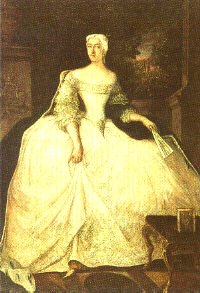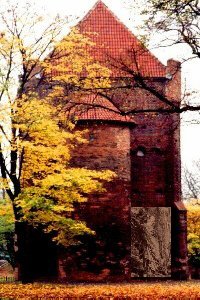 |
W A R N I N G
|
 The White Lady, Kornik
The White Lady, Kornik
If you want to see a spirit of the White Lady
- move mouse on her picture.
In Kornik's castle, in a dining room there is a portrait of Teofila (nee Dzialynska) Szoldrska-Potulicka. The legend says, that supposedly Teofila known as a "White Lady", leaves at night from the portrait and holding her white dress, goes to the park, where she is waited by a cavalier. They ride together, through alleys deepening in the dusk, to disappear with the first rooster.
Near Kornik's castle there was a medieval hunting castle, in which basement there was hidden a great treasure by the last castle owners--Gorka family. This treasure got held by the bad ghosts, forbidding anybody to approach it. Teofila, known for her house-managerial skills and hospitality toward locals, demanded to disassemble the old castle including it's basement. The citizens of Kornik, from recovered bricks, could build chimneys, protecting their homes from the fire. The bad spirits avenged that on Teofila, forcing her to walk on the park, until all of the Gorka's treasure would be discovered. Then the devil's spell on Teofila would lose it's power.
|
Teofila, the owner of the Kornik castle in the second half of 18th Century, was very gifted and broadly educated. Her two unsuccessful marriages caused, that she turned her interests into housekeeping. For example, she rebuilt the castle, giving it the baroque's style, also built a french garden. Probably the legend of "White Lady" started due to Teofila's usual evening walks.
She suffered from migraine headaches, and to feel better, she liked to spend time in her newly designed park.
|

Halszka from Ostrog, Szamotuly
If you want to see a spirit of Halszka
- move mouse on picture of tower.
The tower of Szamotuly castle, known as Tower of Halszka, was the place of
a drama, that initiated the legend of Black Princess. In that tower Halszka from Ostrog was imprisoned. Her husband,
Poznan's governor Lukasz Gorka, ordered to put an iron mask on her face, so nobody could admire his young and attractive wife.
With the black mask on her face, Halszka could walk underground corridors from the tower to the chapel, where she participated in the mass, or atoned for her sins.
The legend says that during full moon in a cloudy night, near the tower, one could see a slowly moving shadow of the woman in a sinner's clothes. When she disappears inside, there are cries and whispering of the spirit of unhappy Halszka, silenced by the tower's thick walls.
|
The marriage of the princess Elizabeth Katherine Ostrogska, aka Halszka, had a long history. She was a daughter of the prince Ilia Ostrogski and Beata Koscielska, the maid of the queen Bona. She was born in Ostrog of Wolyn in 1538. Her father's premature death caused that young girl's life to turn tragic, when she became the custodian of the one of the greatest Polish fortunes, even larger than the one of many Western Europe countries. She was raised in Ostrog by her uncle Wasyl Ostrogski.
She was very pretty (unfortunately, there is no portrait to prove it). There were many candidates for her hand, among them a nephew of her sponsor, prince Dymitr Sanguszko. The prince Dymitr Sanguszko sieged and conquered the castle and forced the marriage. She was then only 14 years old. That event was presented to the king, Zygmunt August, by her mother. As a result Sanguszko was doomed for life. He trapped his wife and ran to near Czechs. Young Sanguszko got murdered there and Halszka returned to her mother as a young widow.
The king gave her then Lukasz Gorka, governor of Poznan, as her husband. The wedding was held in Warsaw's castle conducted by Poznan's bishop. The mother and daughter disagreed with king's ruling and hid in the Lvov's convent. There Halszka, in free will, got married again with Szymon, prince of Sluck. Her rich husband brought her to Szamotuly, where she lived in the years of 1559-73. Halszka was still under big influence of her mother and fully respected her. Her mother influenced her against Lukasz Gorka. After her mother's death, she changed her behavior toward husband, for example, she participated with him in public events. After husband death, she was taken by her uncle to Ostrogi. She died insane at the age of 44, caused probably by the tragical experience of her three marriages.
Halszka went into legend as a person who was hurt as an unlucky suferrer and punished by human's selfishness. Her hardship was a consequence of the fight for the power and big fortune between her mother, her uncle Wasyl and the king Zygmunt August.
It is difficult to judge, what was the role of Lukasz Gorka and whether he really imprisoned his young wife. During her tenure at Szamotuly, the castle was under construction, and people were forced to live in the tower.
Her tragical story inspired many famous artists, i.e., J. I. Kraszewski wrote a nowel "Halszka" and J. Matejko painted her next to Anna Jagiellonka [Polish queen] in his famous "Sermon of P. Skarga" painting.
|
|